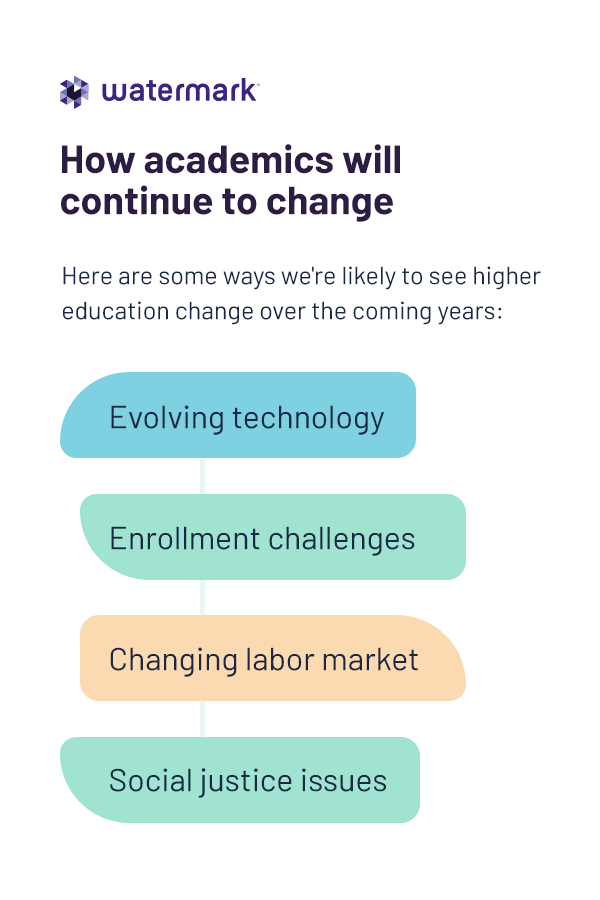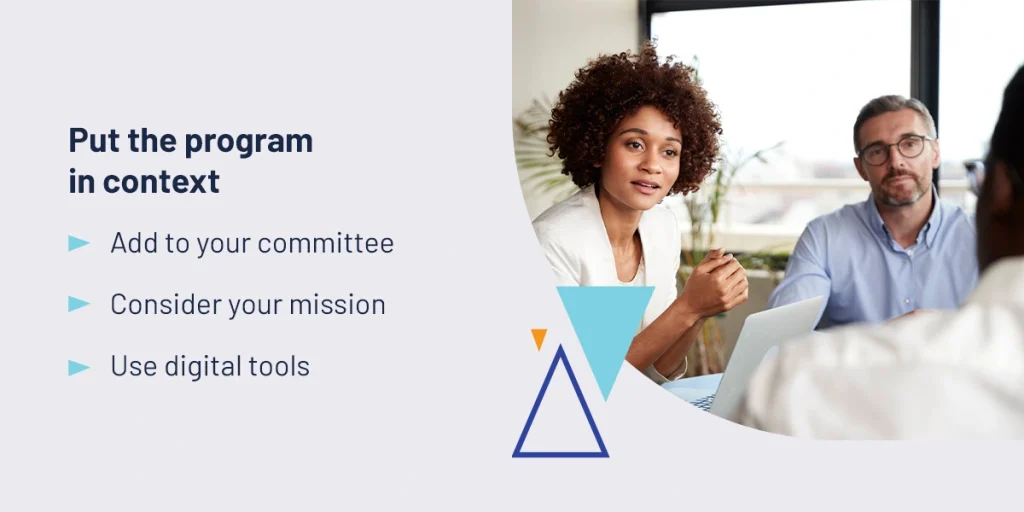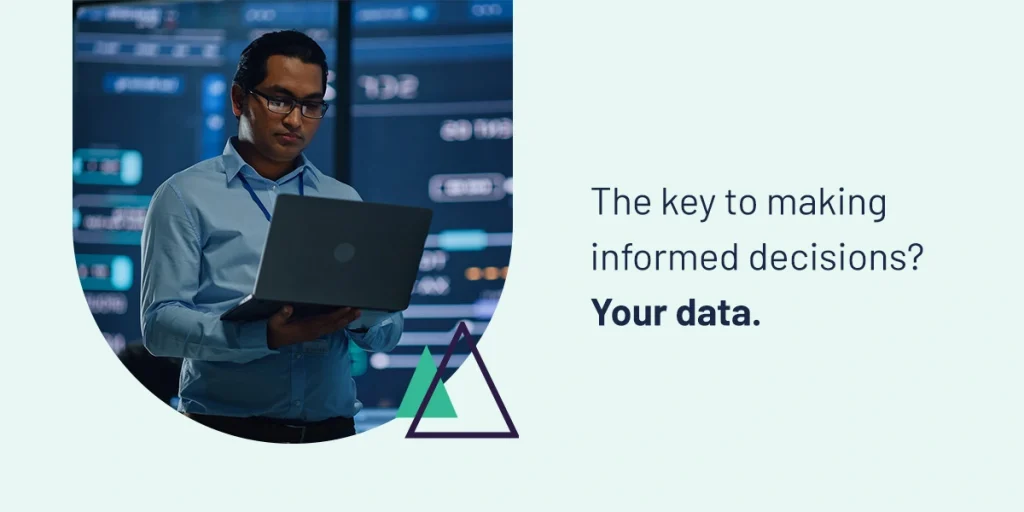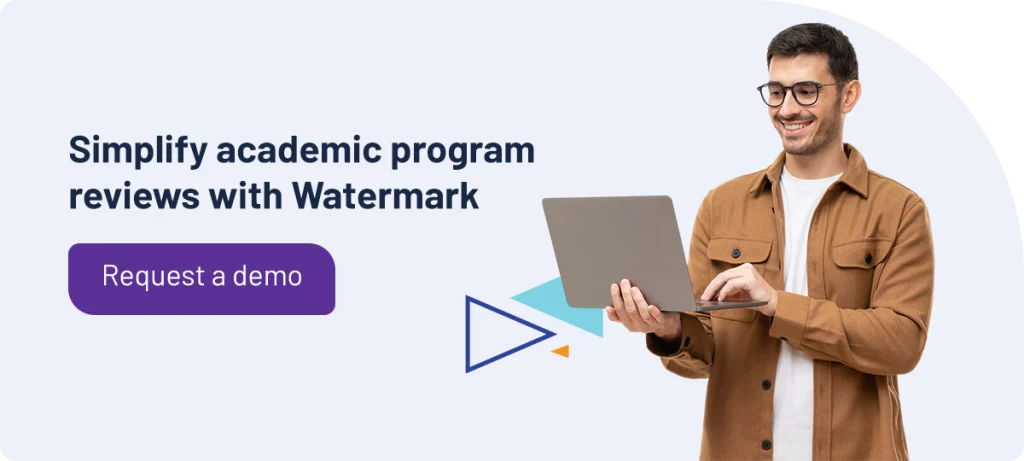
As new technologies evolve, the needs of the modern workforce continue to change. And with the high cost of education, students need to know their investments will help them succeed.
That’s where the program review process comes in. The purpose of academic program review is to continuously improve your institution’s curriculum to drive student success both inside and outside the classroom.
How academics have changed
Higher education today has changed fundamentally from its roots — understanding its evolution can help uncover the reasons behind the challenges institutions face today.
The purpose of higher education, for example, has evolved throughout the centuries. In the United States, it began as a way to train religious ministers. Today, though, there are many reasons people attend higher education:
- Career readiness: Many students view higher education as a way to gain the skills and credentials they need to launch a solid career in their chosen field or to pursue a higher degree.
- Economic mobility: People who hold at least an associate’s degree typically earn higher wages than those who do not, which can help them improve their standard of living.
- Finding a niche: Many students take college as a golden opportunity to explore their interests and find things they’re passionate about, which can help them find a deeply satisfying career path.
- Networking: Building connections with faculty, colleagues, and staff helps students find employment opportunities or references for further education.
- Personal development: Higher education offers students a unique opportunity to expand their horizons and meet people outside their direct community, which can help them develop interpersonal skills and adopt a more open-minded attitude.
Another dramatic change we’ve seen recently was in teaching modalities. At the peak of the COVID-19 pandemic, institutions had to pivot to a completely virtual instruction model, which has since resulted in rising demand for online learning options.
How academics will continue to change

As its history suggests, academia continues to evolve due to a combination of external and internal pressures. Here are some ways we’re likely to see higher education change over the coming years:
- Evolving technology: New technologies, like extended reality, collaboration platforms, and artificial intelligence, can help institutions make higher education more accessible to nontraditional students and people in remote areas.
- Enrollment challenges: As the traditional student population drops, higher education institutions will need to find new ways to reach students who fall outside of that category. Remote and hybrid learning options can help institutions cater to working parents, military service members, students from minority backgrounds, and more.
- Changing labor market: Today’s graduates are entering a completely different workforce than the previous generation. Leveraging labor market data can help inform institutions’ approach to resource allocation, curriculum reform, and student support services for specific programs.
- Social justice issues: Many institutions have adapted their mission statements to address social issues such as racism, gender discrimination, and classism through their programs. As our society continues to progress, the different issues institutions focus on are likely to change as well.
That’s the ultimate goal of academic program review — to create programs that meet students’ current educational needs and prepare them to succeed in a changing world.
How to use academic reviews to ensure a relevant and future-ready curriculum
Academic program review is an important process for ensuring your institution is giving students the skills and knowledge they need to successfully navigate the world post-graduation.
Here are some of the best ways you can ensure your academic program reviews help with curriculum management and institutional health.
1. Engage key stakeholders
Involving your program stakeholders in the academic program review process is essential for maintaining their trust and providing context for your findings.
Similar to the concept in business, program stakeholders include anyone who has a definitive stake in a specific academic program. Some of the stakeholders you may consider reaching out to include:
- Faculty
- Students
- Staff
- Alumni
- Administrators
- Donors and trustees
- Industry experts
- Employers
Connect with these individuals early on in the process and use a mixture of data collection methodologies to ensure you get as many responses as possible.
Some effective methods for collecting stakeholder input include:
- End-of-course surveys: Soliciting student feedback at the end of each semester can reveal whether specific courses and faculty members are effective at meeting their goals. You may want to consider making these surveys mandatory to ensure high participation.
- Email questionnaires: Surveys delivered via email can help you get feedback from external stakeholders like recent alumni, employers, and experts in the field.
- Focus groups: Gathering input from a small group of stakeholders with similar characteristics, such as students or alumni, is helpful for gathering qualitative feedback because the participants can bounce ideas off each other. The interpersonal dynamic provides more well-rounded feedback than an individual survey or interview can gather.
- In-depth interviews: Individually interviewing randomly selected stakeholders can provide deeper, clearer insights into your survey data.
Whatever techniques you use, proper communication with stakeholders is vital for getting the results you want. Make sure they know when their responses are due, and send reminders periodically to encourage participation from anyone who may have forgotten.
2. Put the program in context

Academic programs don’t exist in a vacuum. Each one plays a key role in helping your institution achieve its overall mission and strategic goals.
When you understand how each program contributes to your institution’s mission — both
individually and in conjunction with other programs — you can make better decisions about what steps you should take to improve your offerings.
Here are some ways you can expand your academic program reviews to better contextualize your findings:
- Add to your committee: During the self-study process, go beyond the program in question. Bring in faculty members from other programs to help prevent bias on the self-study committee and to provide fresh perspectives.
- Consider your mission: Compare the program against your overarching institutional mission and strategic direction to understand how the program contributes to your institution as a whole.
- Use digital tools: All the data you collect in your self-study needs to be properly managed to provide actionable insights. Using analytics software designed specifically for educational institutions can help you put your self-study data into context for greater accessibility among stakeholders.
Further, it can help to evaluate how your program compares with similar offerings at peer institutions. Conducting an external benchmarking analysis will provide valuable insight into how your competitors position and manage programs like the one under evaluation.
3. Build a culture of continuous improvement
As we’ve mentioned, continuous improvement is the ultimate goal of academic program review processes.
Regularly updating program curricula and course offerings to reflect the changing needs of our society helps ensure the program is always:
- Relevant
- Rigorous
- Coherent
- High-quality
Developing a culture of continuous improvement among your institutional stakeholders is critical for closing the loop on academic review — without buy-in from your faculty and staff, it’s difficult to successfully implement your action plans, even incrementally.
Some helpful tips for encouraging continuous improvement at your institution include:
- Promoting close collaboration: Effective collaboration at every level, including students, faculty, and administration, is essential for making positive changes. The more people you have contributing to your continuous improvement efforts, the faster you can begin accomplishing the tasks outlined in your program review action plan.
- Establishing a clear vision: A well-defined institutional vision that aligns with your mission will help you determine how to implement any changes your program review revealed were necessary.
- Monitor and track progress: Continuously tracking key performance indicators (KPIs) rather than simply collecting data before each review cycle begins will help you identify gradual changes you can make on an ongoing basis. Smaller changes over long periods of time are often more effective than large-scale adjustments executed once every three to 10 years.
Ultimately, when your entire institution is united in its pursuit of continuous improvement, your stakeholders are more likely to hold each other accountable for sustained program growth and development.
4. Adopt a data-driven approach to change

If your review reveals that you should make changes to the program in question, you need to be smart about how you go about implementing those changes. It’s critical to strike a balance between honoring students’ academic pursuits and meeting your institution’s financial and reputational needs.
The key to making informed decisions? Your data.
At the start of a program review, take time to define the program’s goals and establish which metrics you can track to understand how well it meets those goals. Some examples of quantitative metrics you can use include:
- Graduation rates
- Program completion rates
- Average student performance
- Employment outcomes
- Program costs
Qualitative data, such as student feedback in end-of-course surveys, are just as important when evaluating your programs. Combining both hard empirical data with qualitative feedback will help you gain a comprehensive understanding of the program and its effectiveness.
An integrated data collection and analytics platform can help your institution generate valuable insights into your program. Ideally, it should include intuitive visualization capabilities that help you put the data in context so all stakeholders can understand its relevance.
5. Properly justify launching new programs
Similarly, if you’re considering launching a new program, your program review data will be instrumental in your decision.
Building a process for new programs can help you identify which program ideas have the strongest potential for returns. Some of the supporting documentation required in a new program proposal should include:
- Need and justification: The program proposal should provide plenty of evidence proving there is sufficient demand and interest to justify opening the new program. For example, are job opportunities in the field growing? Would the program help students develop skills that would help them succeed after graduation?
- Existing offerings: Take a look at what your institution already offers and how the new program would fit into your existing catalog. If a similar program exists, you could discuss ways to expand it to meet new demands.
- Available resources: Would you need to hire new faculty for the program? What educational materials would you need to provide? Evaluating your existing funding and faculty expertise will reveal whether your institution has the resources necessary to launch and support a new program.
You also need to apply similar scrutiny to the decision to sunset existing programs:
- Is the program outdated?
- Is program enrollment consistently low or declining?
- Do graduates of this program tend to experience positive employment outcomes?
- Are there improvements your institution can make to update the program?
- What resources does the program use?
Understanding whether a program is worth investing in, whether it already exists in your catalog or you’re adding it, requires sufficient data.
6. Implement a unified software solution
Education technology (edtech) has come a long way in helping institutions harness the full power of their data. Thanks to advancements like the cloud, artificial intelligence (AI), and machine learning (ML), analytics is more comprehensive and straightforward than ever.
A comprehensive suite of fully integrated digital solutions can help you get the most out of your institution’s data by centralizing all your information into one convenient location.
For example, your edtech software suite might include the following program review solutions:
- Student success: Student success and engagement software can analyze data concerning student behavior and performance, which could generate deep insights into program effectiveness. For example, you could use this information to determine whether adjusting a program’s curriculum could re-engage at-risk students.
- Assessment: An assessment and accreditation management solution simplifies accreditation prep and academic program reviews by promoting better collaboration and engagement among self-study committee members. Plus, pre-built and custom report templates streamline self-study documentation so you can comply with the standards of each program’s accreditation body.
- Evaluations and surveys: An integrated system that pulls data from stakeholder surveys and evaluations helps you apply that feedback to your program reviews, helping you put your quantitative review data into context.
- Labor market data integrations: Access to the most current labor market data available can help you understand what skills, knowledge, and credentials employers are looking for now and in the coming years. An analytics solution that integrates with a reliable labor market database enables you to determine how well your programs deliver on those goals.
- Curriculum management: Effective curriculum management software allows you to create user-friendly curriculum maps, making it easy to identify learning gaps, evaluate the course sequence, and more.
Ultimately, the better your users can navigate the software, the better your results are likely to be. That’s why the software vendor you choose to work with should provide ongoing support and education services to ensure you can get the most out of your investment.
Simplify academic program reviews with Watermark
If your institution is looking for a unified software solution that will streamline your academic program review process, Watermark is here to help. Our fully integrated Educational Impact Suite (EIS) centralizes all your academic and student data, including student surveys, curriculum maps, faculty activity, and more for easy access and analysis.
Watermark Course Evaluations & Surveys solution enables you to pull answers from end-of-course surveys and generate rich, user-friendly visualizations to inform curriculum decisions. Build accessible curriculum maps with Watermark Curriculum Strategy to streamline curriculum development and catalog creation.
Streamline the academic program review process with advanced higher education data management solutions from Watermark. Get started today with a personalized demo.
















































































































































































































































































































































































































